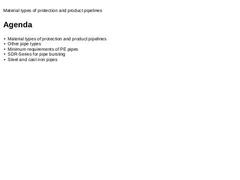
|
|
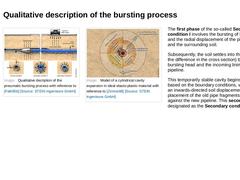
|
(Image: Qualitative decription of the pneumatic bursting process with reference to [Falk95b] [Image: S&P GmbH]) (Image: Model of a cylindrical cavity expansion in ideal elasto-plastic material with reference to [Zimme88] [Image: S&P GmbH]) The first phase of the so-called Secondary condition I involves the bursting of the old sewer and the radial displacement of the pipe fragments and the surrounding soil. Subsequently, the soil settles into the overcut ( … |
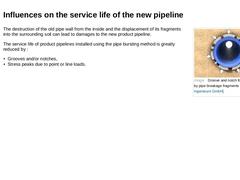
|
(Image: Groove and notch formation caused by pipe breakage fragments) The destruction of the old pipe wall from the inside and the displacement of its fragments into the surrounding soil can lead to damages to the new product pipeline. The service life of product pipelines installed using the pipe bursting method is greatly reduced by : -
Grooves and/or notches,
-
Stress peaks due to point or line loads.
|
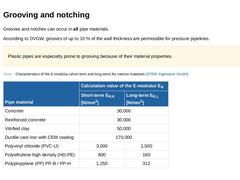
|
Grooves and notches can occur in all pipe materials. According to DVGW, grooves of up to 10 % of the wall thickness are permissible for pressure pipelines. Plastic pipes are especially prone to grooving because of their material properties. (Table: Characteristics of the E-modulus (short term and long term) for various materials) |
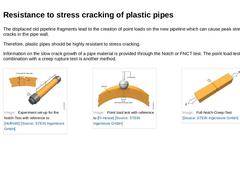
|
The displaced old pipeline fragments lead to the creation of point loads on the new pipeline which can cause peak stresses and thus cracks in the pipe wall. Therefore, plastic pipes should be highly resistant to stress cracking. Information on the slow crack growth of a pipe material is provided through the Notch or FNCT test. The point load test in combination with a creep rupture test is another method. (Image: Experiment set-up for the Notch-Test … |
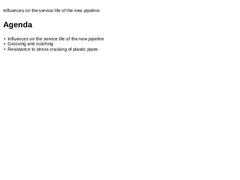
|
|
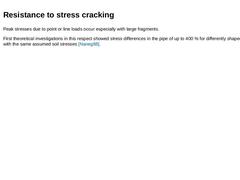
|
Peak stresses due to point or line loads occur especially with large fragments. First theoretical investigations in this respect showed stress differences in the pipe of up to 400 % for differently shaped fragments with the same assumed soil stresses [Naneg88]. |
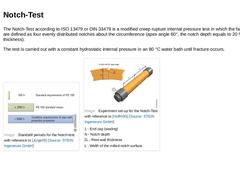
|
The Notch-Test according to ISO 13479 or DIN 33479 is a modified creep rupture internal pressure test in which the failure points are defined as four evenly distributed notches about the circumference (apex angle 60°, the notch depth equals to 20 % of the wall thickness). The test is carried out with a constant hydrostatic internal pressure in an 80 °C water bath until fracture occurs. (Image: Standstill periods for the Notch-test with reference to [… |
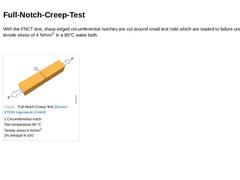
|
With the FNCT test, sharp-edged circumferential notches are cut around small test rods which are loaded to failure under a constant tensile stress of 4 N/mm2 in a 80°C water bath. (Image: Full-Notch-Creep-Test) |
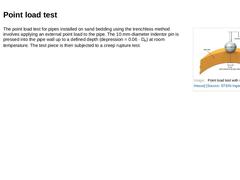
|
(Image: Point load test with reference to [FI-Hesse] [Image: S&P GmbH]) The point load test for pipes installed on sand bedding using the trenchless method involves applying an external point load to the pipe. The 10 mm-diameter indentor pin is pressed into the pipe wall up to a defined depth (depression = 0.06 · De) at room temperature. The test piece is then subjected to a creep rupture test. |
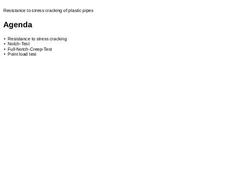
|
|

|
|
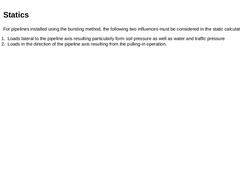
|
For pipelines installed using the bursting method, the following two influences must be considered in the static calculations: -
Loads lateral to the pipeline axis resulting particularly form soil pressure as well as water and traffic pressure
-
Loads in the direction of the pipeline axis resulting from the pulling-in operation.
|
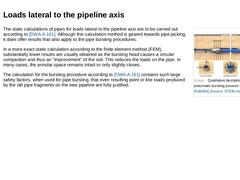
|
(Image: Qualitative decription of the pneumatic bursting process with reference to [Falk95b] [Image: S&P GmbH]) The static calculations of pipes for loads lateral to the pipeline axis are to be carried out according to [DWA-A 161]. Although this calculation method is geared towards pipe jacking, it does offer results that also apply to the pipe bursting procedures. In a more exact static calculation according to the finite element method (FEM), substantially … |
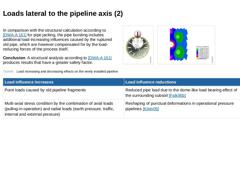
|
In comparison with the structural calculation according to [DWA-A 161] for pipe jacking, the pipe bursting includes additional load-increasing influences caused by the ruptured old pipe, which are however compensated for by the load-reducing forces of the process itself. Conclusion: A structural analysis according to [DWA-A 161] produces results that have a greater safety factor. (Image: Point load test with internal pressure with reference to [Jürge05] [… |
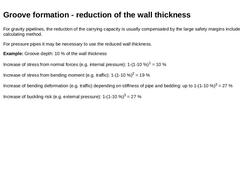
|
For gravity pipelines, the reduction of the carrying capacity is usually compensated by the large safety margins included in the calculating method. For pressure pipes it may be necessary to use the reduced wall thickness. Example: Groove depth: 10 % of the wall thickness Increase of stress from normal forces (e.g. internal pressure): 1-(1-10 %)1 = 10 % Increase of stress from bending moment (e.g. traffic): 1-(1-10 %)2 = 19 % Increase of bending deformation (… |
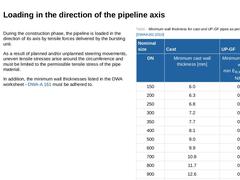
|
During the construction phase, the pipeline is loaded in the direction of its axis by tensile forces delivered by the bursting unit. As a result of planned and/or unplanned steering movements, uneven tensile stresses arise around the circumference and must be limited to the permissible tensile stress of the pipe material. In addition, the minimum wall thicknesses listed in the DWA worksheet - [DWA-A 161] must be adhered to. (Table: Minimum wall thickness … |
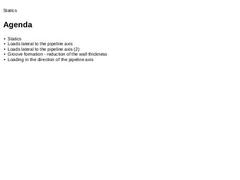
|
|
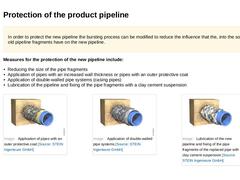
|
In order to protect the new pipeline the bursting process can be modified to reduce the influence that the, into the soil displaced, old pipeline fragments have on the new pipeline. Measures for the protection of the new pipeline include: -
Reducing the size of the pipe fragments
-
Application of pipes with an increased wall thickness or pipes with an outer protective coat
-
Application of double-walled pipe systems (casing pipes)
-
Lubrication of the …
|
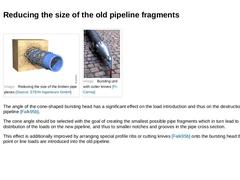
|
(Image: Reducing the size of the broken pipe pieces) (Image: Bursting unit with cutter knives [FI-Cerma]) The angle of the cone-shaped bursting head has a significant effect on the load introduction and thus on the destruction of the old pipeline [Falk95b]. The cone angle should be selected with the goal of creating the smallest possible pipe fragments which in turn lead to a more even distribution of the loads on the new pipeline, and thus to smaller … |
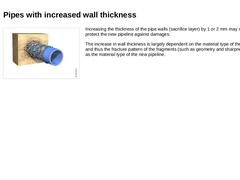
|
(Image: Reducing the size of the broken pipe pieces) Increasing the thickness of the pipe walls (sacrifice layer) by 1 or 2 mm may serve to protect the new pipeline against damages. The increase in wall thickness is largely dependent on the material type of the old pipeline, and thus the fracture pattern of the fragments (such as geometry and sharpness), as well as the material type of the new pipeline. |
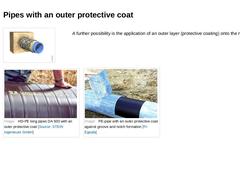
|
(Image: Application of pipes with an outer protective coat) A further possibility is the application of an outer layer (protective coating) onto the new pipeline. (Image: HD-PE long pipes DA 500 with an outer protective coat) (Image: PE-pipe with an outer protective coat against groove and notch formation [FI-Egepla]) |
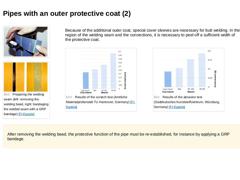
|
(Image: Peeling off the protective coat of an Egeplast Saftey-Line coated pipe (SLM) [FI-Egepla]) (Image: Preparing the welding seam (left: removing the welding bead, right: bandaging the welded seam with a GRP bandage) [FI-Egepla]) Because of the additional outer coat, special cover sleeves are necessary for butt welding. In the region of the welding seam and the connections, it is necessary to peel off a sufficient width of the protective coat. |
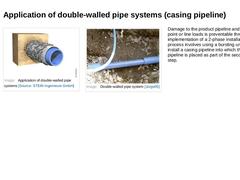
|
(Image: Application of double-walled pipe systems) (Image: Double-walled pipe system [Jürge05]) Damage to the product pipeline and loading by point or line loads is preventable through the implementation of a 2-phase installation. This process involves using a bursting unit to first install a casing pipeline into which the product pipeline is placed as part of the second working step. |
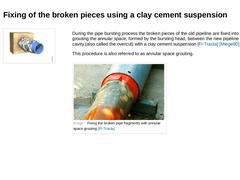
|
(Image: Lubrication of the new pipeline and fixing of the pipe fragments of the replaced pipe with a clay cement suspension) During the pipe bursting process the broken pieces of the old pipeline are fixed into place by grouting the annular space, formed by the bursting head, between the new pipeline and the cavity (also called the overcut) with a clay cement suspension [FI-Tracta] [Miege90] [Falk95b]. This procedure is also referred to as annular … |